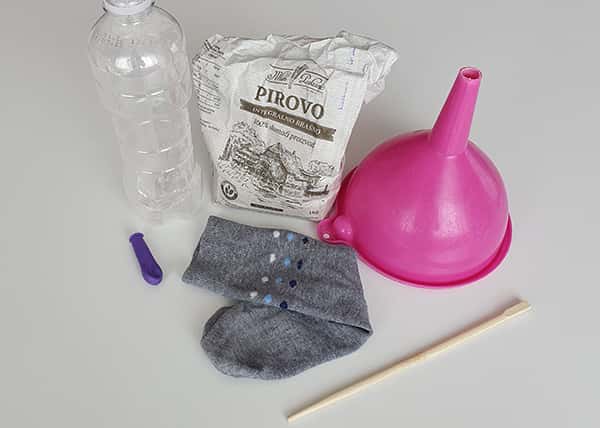If you ever feel under the pressure and stress (and who doesn’t?) we have something for you. Why not make your own anti-stress ball from balloon and flour. Let’s go to the kitchen and make the activity that will help in coping with stressful situations in a non-harmful way
Article Contents
1. What is Stress and Why Do We Feel It?2. How to Cope With Stress?
3. Materials needed to make a DIY Stress Ball
4. Step by Step Guide to Making Homemade Stress Ball
5. What will you Develop and Learn when making the Anti Stress Ball?
What is Stress and Why Do We Feel It?
Stress is defined as a feeling of emotional and/or physical tension. Stress can be caused by some event or from our thoughts and how we interpret our surroundings.
In simple terms, stress is the body’s reaction to some challenge or threat that we face. It can energize us and in short bursts, it can be positive. It drives us to take action and remove the source of stress. But when stress becomes long-term and we can’t resolve the source of stress, it can have drastic negative consequences on our physical and mental health.

Short-term stress is also called acute stress. This type of stress helps us manage dangerous and exciting situations and is gone as soon as we resolve the situation. For example, if we see a snake in the grass, we will feel acute stress which will energize us to jump away and move from the snake. As soon as we move to a secure location, the acute stress is gone.
Long-term stress is also called chronic stress. Chronic stress can last for weeks, months, and even years, and often we get so used to it that we even don’t realize we are suffering from chronic stress. That’s why it is so dangerous – it can seriously damage our health over time. For example, problems in school or work, fighting among family members, or being a victim of a bully can cause chronic stress.
How to Cope With Stress?
There are many strategies to cope with stress and different people use different strategies. That is OK, but nonetheless, there are some nonoptimal ways to cope with stress like biting nails, chewing hair, biting lips, etc. But there are even more damaging strategies that people use, like overeating, alcohol, and tobacco consumption.

The best way to deal with stress is to remove the source of it. But we all know that often isn’t possible. That’s why we will mention some of the strategies to deal with stress that can’t be removed, like when waiting for the exam results or waiting for that big interview to start.
- Deep breathing. This is one of the more efficient and simple strategies we can use. Long inhales and exhales will help our body to calm and our mind to focus.
- Talking to other people. Searching for social support from people we are close to can be a great way to relieve some of the stress. So don’t hesitate to share your worries from time to time.
- A stress relief ball or fidget toy. This can help in getting out that excess energy and serve as a healthy alternative to behaviors like biting nails or hair.
- Exercise! Physical activity has a big positive effect on coping with stress. Just getting up, walking, or doing a couple of pushups will help us in relieving some stress.
- Do things you love. Don’t forget to take a break and do the things you really enjoy when you are under the stress. Anything from a relaxing bath to watching your favorite show will help in feeling better when we are feeling under a lot of pressure.
After a couple of tips for coping with stress, let’s go and make one by ourselves – an anti-stress ball!
Materials needed to make a DIY Stress Ball

- Balloon. We will need a round balloon for this since long (modeling) balloons don’t have a ball shape. Size really doesn’t matter. We used small, water balloons but even bigger balloons will be good for our stress relief ball. You can find balloons in almost any supermarket.
- Flour. Any flour you find in the kitchen will be good. You can even experiment with making different antistress balls with different flours. Every flour has a different texture so our antistress ball will feel different on touch depending on which flour we used. 100 – 200 grams of flour will be enough, depending on the size of the balloon you use.
- Funnel. We will need a kitchen funnel to easily put flour in a plastic bottle. Without a funnel, it is really hard to pour flour through the small hole of a plastic bottle. We can also improvise, and create a funnel from paper – anything that will ease our process of pouring flour into the bottle.
- Plastic Bottle. A (plastic) bottle plays important role in moving flour into the balloon. Without it, it wouldn’t be possible to put the flour into the balloon since it would deflate constantly. 0.5 liter bottle will work great but even bigger bottles will work. Important thing is that we can put a balloon over the bottle opening so the air can’t run out from the balloon.
- Wooden Stick. Stick is optional but it can help in speeding up the process. We can use a wooden stick to help flour go faster through the funnel into the bottle.
- Sock. Sock is also optional but useful if we want to make our stress ball more resistant. Next to the sock, we can also use some other piece of cloth to wrap our stress ball in, to make it more sturdy.
Step by Step Guide to Making Homemade Stress Ball
If you’re interested in video instructions on how to make our balloon stress ball activity, you can find the video at the beginning of the article. And for step-by-step, text instructions, continue reading.
- Add the flour to the bottle. The first thing we need to do is to prepare the flour we will use to fill the balloon. We will need to add the flour to the bottle first so we are able to fill the balloon later. A small plastic bottle will work fine, although any size bottle will work, as long as we can put a balloon opening over the bottle opening. We should use a kitchen funnel for easier filling of the bottle with flour. Also, a wooden stick will help us if the flour is getting stuck inside the funnel. Add around 100 to 200 grams of flour to the bottle.
- Blow the balloon. Blow the balloon the half of its maximum capacity if you are using a small, water balloon. If you are using a bigger balloon, blow it with 1 or 2 breaths. Hold the balloon opening so the air can’t get outside but don’t tie it.
- Attach the balloon to the bottle. Now a bit tricky part. We need to put balloon opening on top of the bottle opening. It is easier if our balloon is not full of air since it will be more flexible. Try to use your fingers to stretch the balloon hole, while keeping the balloon pressed above the opening so the air can’t go outside. After you manage to attach the balloon to the bottle, air won’t be able to go outside and we will be able to fill the balloon with flour.
- Transfer flour from bottle to balloon. Turn the bottle upside down and shake it gently until all flour goes inside the balloon. Detach the balloon from the bottle.
- Finish the stress ball. Gently left excess air to go out of the balloon so there is no air left. Do it gently or the flour may start to go outside too! After all of the air is out of the balloon, tie it, and you are done!
- Bonus: Add the balloon into the sock. To make the stress ball much more durable, a simple trick is to put it into one sock. Just add it to the sock and tie the sock so our stress ball is secured inside. This way, the fragile balloon layer is protected and our stress ball will be able to take much more… Stress!
What will you Develop and Learn when making the Anti Stress Ball?
- How to cope with stress. There are many nonoptimal methods that people use in coping with stress. With this activity, we can talk to children about stress, how to recognize it and how to cope with it. And we are making the perfect tool that can help us in coping with stress in a safe way.
- Creativity. This activity teaches how we can create many things from simple materials that we already have. It shows us how, using a creative way of thinking, we can create new ideas and find solutions to most problems.
- Hand-eye Coordination. Anti-stress ball activity requires some accurate and precise moves. When putting the balloon over the bottle and tying the balloon, we will improve our hand-eye coordination and fine mother skills.
- Explore different textures. We can use different types of flour to create our stress balls. Every flour has a different texture so our stress balls will also feel much different when we squeeze them.
We hope you enjoyed this activity, and if you are in search of more DIY activities for kids, we have some to recommend:
- If you have balloons to spare and are interested in more fun balloon activities, be sure to check 5 amazing Balloon experiments for a lot more fun and learning with the balloons.
- And for another activity that can help with stress relief and it’s easy to make at home, check the How to make Fidget Spinner activity.
- If you are into learning physics using the balloon, you should definitely check the How to Demonstrate Air Pressure with Balloon article.
- And for another activity that is great for sensory stimulation with a calming effect, check the How to make Sensory Bag for Child Sensorimotor development activity. It is great for babies but everyone can feel positive effects from this great sensory bag.
Until next time, and may the stress be far away from you.
If you’re searching for some great STEM Activities for Kids and Child development tips, you’re in the right place! Check the Categories below to find the right activity for you.

STEM Science
Videos, guides and explanations about STEM Science in a step-by-step way with materials you probably already have at your home. Find new Science ideas.
Read more
STEM Technology
Videos, guides and explanations about STEM Technology in a step-by-step way with materials you probably already have at your home. Find new Technology ideas.
Read more
STEM Engineering
Videos, guides and explanations about STEM Engineering in a step-by-step way with materials you probably already have at your home. New Engineering ideas!
Read more
STEM Math
Videos, guides and explanations about STEM Math in a step-by-step way with materials you probably already have at your home. Find new Mathematics ideas.
Read more
Psychology
Find out all about development psychology topics that you always wanted to know. Here are articles from child psychology and development psychology overall.
Read more
First year of Child’s Life
Following a Child’s development every month from its birth. Personal experiences and tips on how to cope with challenges that you will face in parenting.
Read more